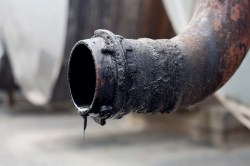Until the Pegasus pipeline ruptured on March 29, leaking an estimated 147,000 to 210,000 gallons of heavy crude oil into the town of Mayflower, Ark., few Arkansans knew it was even there.
In fact, thousands of miles of pipelines snake through the heart of the United States. Proponents insist that pipelines are the safest way to transport oil — safer than trucks or trains or tankers. Yet, in recent years, the Yellowstone River spill in Montana, the Kalamazoo River spill in Marshall, Mich., and now the Mayflower spill have alerted Americans to the dirty dangers that lurk underneath the country.
There are 175,000 miles of onshore and offshore “Hazardous Liquid” pipelines pumping petroleum and its byproducts across the United States, according to the U.S. Department of Transportation’s Pipeline & Hazardous Materials Safety Administration, which oversees all pipelines. From 1990 to 2011, more than 110 million gallons of mostly crude oil and petroleum products spilled from these pipelines, many of which now carry chemicals that are much different than those for which they were designed.
Most of these spills go unreported by the press, but activists hope that the sight of black crude oozing through a subdivision of $200,000 brick homes in Mayflower, a town of 2,200 about 25 miles north of Little Rock, will spark the public’s ire, driving change on both the local and national levels.
More than 13 miles of the 858-mile Pegasus pipeline run through the Lake Maumelle watershed, the major water supply for Little Rock, the state capital, with a metro region of more than 700,000 people. If the Mayflower rupture had occurred near Lake Maumelle, the results could have been catastrophic, potentially poisoning the water supply of hospitals, restaurants, and households. The cleanup could have taken months or even years. The fallout would have cost millions.
“It would jeopardize the entire economy of central Arkansas that relies on the lake for clean, dependable water,” says Barry Haas, spokesperson for the grassroots group Citizens Protecting Maumelle Watershed.
Haas has sent a letter on behalf of his group to Rex Tillerson, chair and CEO of ExxonMobil, which owns Pegasus, asking the company to move the pipeline from the watershed. Central Arkansas Water, a water supply utility, also wants ExxonMobil to move the pipeline. The utility had expressed concerns about Pegasus even before the Mayflower spill.
This week, a new coalition called All Risk, No Reward launched to persuade President Obama and Secretary of State John Kerry to reject to the proposed Keystone XL pipeline that will flow 1,179 miles from Canada through the Midwest. The coalition used the Mayflower incident as a central argument against Keystone. The group also called out Alberta Premier Alison Redford, who is visiting Washington this week from Canada, to promote the tar-sands project.
Pipelines — and the content they carry — have changed vastly since World War II. A network of pipes that once carried black gold to fuel this nation’s economy now carries large quantities of crude from Canada. Most of this type of oil isn’t even used in the United States, but rather exported to foreign countries.
The Pegasus pipeline, constructed in 1948, initially delivered light, conventional crude oil from Nederland, Texas, to the Patoka Oil Terminal Hub in Patoka, Ill. At some point, the petroleum began flowing in the opposite direction, and light crude oil switched to heavy oil. ExxonMobil has said that the pipeline did not carry Canadian tar-sands oil. On its corporate blog, a company spokesman described the pipeline’s content as “Wabasca heavy oil” which is “from Alberta near the area where there is oil sands production.” Environmentalists, however, argue that the crude is tar-sands oil.
A 2009 ExxonMobil press release announcing the completion of the Pegasus pipeline retrofit said that project would “enable the transportation of additional Canadian crude from the Midwest to Gulf Coast refineries.” It added that the pipeline had “operational enhancements, such as new leak detection technology.”
But the Mayflower spill highlights the danger of pipelines in this brave new world of oil. Aging pipelines like Pegasus now transport thicker, more corrosive oil than that for which they were originally designed. And watchdog groups say they do this with very little oversight from state or federal regulators.
Rita Beving, a consultant for the Texas office of Public Citizen, a national nonprofit consumer advocacy organization, says that pipeline companies are in a race to land lucrative shipping contracts with Texas refineries.
“Why should pipeline companies apply for permits and go through tedious environmental impact statements [required for new pipelines],” she asks, “when you can repurpose an old pipeline with little, if any, environmental scrutiny from a state agency, and with little resistance from landowners who already have an existing line in the ground?”
The residents of Mayflower, Ark., can tell you why. While ExxonMobil claims the Pegasus pipeline was outfitted with 21st-century safety features, that’s cold comfort to those living near it.
“Any rupture of the pipeline within the Lake Maumelle watershed, even if discovered immediately and the valves shut off instantly, which is not what would happen in reality, risks 1.25 million gallons of this goo leaking out,” Haas says. “We cannot play Russian roulette with the public drinking water supply for 400,000 people. That’s simply unacceptable.”




